Large chromosomal deletions and heritable small genetic changes induced by CRISPR/Cas9 in rice
- PMID: 25200087
- PMCID: PMC4176183
- DOI: 10.1093/nar/gku806
Large chromosomal deletions and heritable small genetic changes induced by CRISPR/Cas9 in rice
Abstract
The Cas9/sgRNA of the CRISPR/Cas system has emerged as a robust technology for targeted gene editing in various organisms, including plants, where Cas9/sgRNA-mediated small deletions/insertions at single cleavage sites have been reported in transient and stable transformations, although genetic transmission of edits has been reported only in Arabidopsis and rice. Large chromosomal excision between two remote nuclease-targeted loci has been reported only in a few non-plant species. Here we report in rice Cas9/sgRNA-induced large chromosomal segment deletions, the inheritance of genome edits in multiple generations and construction of a set of facile vectors for high-efficiency, multiplex gene targeting. Four sugar efflux transporter genes were modified in rice at high efficiency; the most efficient system yielding 87-100% editing in T0 transgenic plants, all with di-allelic edits. Furthermore, genetic crosses segregating Cas9/sgRNA transgenes away from edited genes yielded several genome-edited but transgene-free rice plants. We also demonstrated proof-of-efficiency of Cas9/sgRNAs in producing large chromosomal deletions (115-245 kb) involving three different clusters of genes in rice protoplasts and verification of deletions of two clusters in regenerated T0 generation plants. Together, these data demonstrate the power of our Cas9/sgRNA platform for targeted gene/genome editing in rice and other crops, enabling both basic research and agricultural applications.
© The Author(s) 2014. Published by Oxford University Press on behalf of Nucleic Acids Research.
Figures
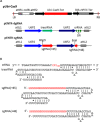

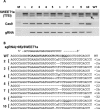
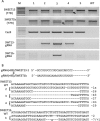

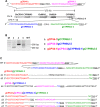

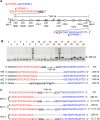
Similar articles
-
A Robust CRISPR/Cas9 System for Convenient, High-Efficiency Multiplex Genome Editing in Monocot and Dicot Plants.Mol Plant. 2015 Aug;8(8):1274-84. doi: 10.1016/j.molp.2015.04.007. Epub 2015 Apr 24. Mol Plant. 2015. PMID: 25917172
-
Creating Large Chromosomal Deletions in Rice Using CRISPR/Cas9.Methods Mol Biol. 2019;1917:47-61. doi: 10.1007/978-1-4939-8991-1_4. Methods Mol Biol. 2019. PMID: 30610627
-
A large-scale whole-genome sequencing analysis reveals highly specific genome editing by both Cas9 and Cpf1 (Cas12a) nucleases in rice.Genome Biol. 2018 Jul 4;19(1):84. doi: 10.1186/s13059-018-1458-5. Genome Biol. 2018. PMID: 29973285 Free PMC article.
-
On Improving CRISPR for Editing Plant Genes: Ribozyme-Mediated Guide RNA Production and Fluorescence-Based Technology for Isolating Transgene-Free Mutants Generated by CRISPR.Prog Mol Biol Transl Sci. 2017;149:151-166. doi: 10.1016/bs.pmbts.2017.03.012. Epub 2017 May 3. Prog Mol Biol Transl Sci. 2017. PMID: 28712495 Review.
-
Cas9/sgRNA-based genome editing and other reverse genetic approaches for functional genomic studies in rice.Brief Funct Genomics. 2018 Sep 27;17(5):339-351. doi: 10.1093/bfgp/ely010. Brief Funct Genomics. 2018. PMID: 29579147 Review.
Cited by
-
Use of CRISPR Technology in Gene Editing for Tolerance to Biotic Factors in Plants: A Systematic Review.Curr Issues Mol Biol. 2024 Oct 2;46(10):11086-11123. doi: 10.3390/cimb46100659. Curr Issues Mol Biol. 2024. PMID: 39451539 Free PMC article. Review.
-
Egg cell-specific promoter-controlled CRISPR/Cas9 efficiently generates homozygous mutants for multiple target genes in Arabidopsis in a single generation.Genome Biol. 2015 Jul 21;16(1):144. doi: 10.1186/s13059-015-0715-0. Genome Biol. 2015. PMID: 26193878 Free PMC article.
-
Efficient expression of multiple guide RNAs for CRISPR/Cas genome editing.aBIOTECH. 2020 Jan 23;1(2):123-134. doi: 10.1007/s42994-019-00014-w. eCollection 2020 Apr. aBIOTECH. 2020. PMID: 36304720 Free PMC article. Review.
-
Heat-shock-inducible CRISPR/Cas9 system generates heritable mutations in rice.Plant Direct. 2019 May 29;3(5):e00145. doi: 10.1002/pld3.145. eCollection 2019 May. Plant Direct. 2019. PMID: 31404128 Free PMC article.
-
Targeted deletion of rice retrotransposon Tos17 via CRISPR/Cas9.Plant Cell Rep. 2019 Apr;38(4):455-458. doi: 10.1007/s00299-018-2357-7. Epub 2018 Nov 21. Plant Cell Rep. 2019. PMID: 30465094
References
Publication types
MeSH terms
Substances
LinkOut - more resources
Full Text Sources
Other Literature Sources

